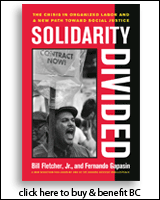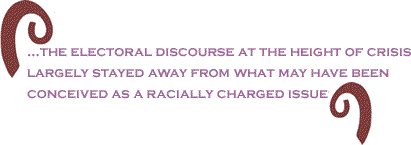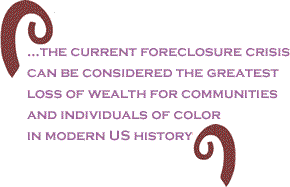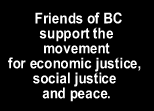
|
|||||||||||||||||||||||

|
|

Custom Search
|
|
 |
|
With the collapse of several banks and insurance companies, the near bankruptcy of Detroit automakers, a 50 percent drop in world stock exchanges and an almost complete arrest of credit markets, an economic era has ended. It seems almost an understatement to say that capitalism has entered a new stage of a protracted systemic crisis. The crisis of the economy is at once, a crisis in ideology. After 30 years of worship at the shrine of the free market, Reaganomics and other branches of conservative and neo-conservative thought seem bankrupt and thoroughly discredited, if not dead - and not only right-wing schools. Deregulation, privatization, intense financial speculation on debt, the scaling back if not elimination of government social spending, in a word, “neo-liberalism” has reached its extreme limit almost bursting state-monopoly capitalism’s seams and triggering a worldwide financial meltdown.
Slouching Toward Collapse The origins of how the unraveling began is to be found in capitalism’s attempt to resolve ongoing crises. In fact, the neo-liberal model itself arose in response to attempts in advanced capitalist countries to maintain profits and find new markets. Faced in the 1970s with a declining rate of profit, a fractured world economy divided into “socialist” and capitalist camps, structural and fiscal crises along with spiraling inflation, capitalism’s generals undertook a re-forging of economic policy in the form of a wholesale assault on the edifice of the New Deal. Keynesianism had run into a wall - at least from the point of view of big capital - and policy was now modulated to fit the maximum profit categorical imperatives of the new period. International trade pacts were formed, unions were rolled backed or held in check and fiscal policy was loosened, as a new “post-industrial” service-oriented economy emerged.
Finance capital began to play an increasingly dominant role. Stressing this aspect Sam Webb writes:
When, at times confronted with cyclical episodes of economic instability amid the bursting of speculative bubbles, monetarist solutions were seen as a panacea. Strengthening money supply from monopoly capital’s point of view may have helped but in contradictory ways as wages, particularly after the recession of 2001, remained stagnant or declined. At key moments in the cycle, crisis emerged. With worker compensation nearly frozen, where was the purchasing power necessary to keep the circulation process moving? Resolving this problem was a chief preoccupation of bankers, CEOs and bureaucratic policy-makers alike. Indeed, a study of productivity and wages over the last quarter century reveals the acuteness of the problem. From the mid-1970s on, driven by speed-up and new technology, productivity increased dramatically, particularly after 2000. Pay however, remained stagnant. Tracing patterns of pay and productivity, an economist writing for the The Daily Kos noted:
 John Bellamy Foster and Harry Magdoff in an important article in Monthly Review, titled, “Financial Implosion and Stagnation”, also mention the equation of productivity and wages:
Debt accumulation was key. Speculative bubbles (in information technology and housing) became a driving force in overcoming each new crisis point. Low long-term interest rates had allowed large numbers of people to purchase homes. With rising home prices, experiencing growing debt - and lured by an intensive marketing campaign in the ‘90s by Citicorp and others - families took out second mortgages en masse. “Until the early ‘90s,” comments Robert Brenner at the November 2008 Berlin symposium organized by the Rosa Luxemburg Foundation, “Bubblenomics allowed people to get wealthy they thought on paper. One hundred percent of wealth is driven by borrowing and consumption, borrowing and residential investments.” Desperately Seeking Higher Profits
The proliferation of sub prime loans can be traced to the aftermath of the dot-com bubble. After the bubble burst, speculators turned to the housing market. As Yale economist, Robert Shiller, asked in 2005, “Once stocks fell, real estate became the primary outlet for the speculative frenzy that the stock market had unleashed. Where else could plungers apply their newly acquired trading talents?” As it turned out, the supply-sider’s solution to the precipitous decline in technology stocks achieved a momentary short-term fix, but carried within it seeds of a more profound and destructive crisis. The editors of the German magazine, Der Spiegel, in a recent article spelling the displacement of US capital, argued that, “once again, Greenspan flooded the economy with money and, yet again, Wall Street started looking for a new market for its growth machine. This time it discovered the American homeowner, convincing him to take out mortgages at favorable terms, even when there was practically no collateral.” Capital then flooded the housing market as real estate became a national corporate mania. “These days, the only thing that comes close to real estate as a national obsession is poker,” commented Shiller.
“What saved the day? Just when the conforming mortgages were falling non-conforming mortgages, sub prime or ‘alt A’ or ‘liars loans’ take over in driving the bubble.” The Federal Reserve, as suggested by Der Spiegel, was directly responsible. Brenner confirmed this thesis; “Sub prime mortgages,” he said, “became so possible, because Greenspan came in again and reduced short term interest rates to one percent in 2003, the lowest of the postwar period in the face of this problem, which meant that for two years real short term interest rates were below 0. And he did that because sub prime mortgages are governed by variable interest rates.” In article at Portfolio.com titled, “The End of Wall Street’s Boom,” writer Michael Lewis also emphasized the role of the new niche market: “More generally, the sub prime market tapped a tranche of the American public that did not typically have anything to do with Wall Street. Lenders were making loans to people who, based on their credit ratings, were less creditworthy than 71 percent of the population.”
Lewis described with precision the means by which the process was begun - short selling the market - and uncovers just how deep finance capital’s complicity ran. “The big Wall Street firms,” Lewis argued, “had just made it possible to short even the tiniest and most obscure sub prime-mortgage-backed bond by creating, in effect, a market of side bets.” Lewis,
himself the author of a best-selling whistle-blowing 1980s expose
of Wall Street, Liar's
Poker: Rising Through the Wreckage on Wall Street
The answer: profits. So profit hungry were the Wall Street traders that they pushed these new mechanisms to their farthest limit, creatively manipulating what Marx called fictitious capital. Lewis noted:
Not only did banks and investment firms create this phony capital, there was ruling class complicity all down the line, a complicity that included, in addition to the Republican standard bearers, Democratic centrists like former Treasury Secretary Robert Rubin, then an executive of the recently bailed out Citicorp. The
beginning of the end came in 2006, according to the editors of
Monthly Review: Frantic efforts to throw more money at the problem, so often criticized by the Republican right when applied to social programs, proved of no avail. Foster and Magdoff write that the new chief US financial officer, ever the student of Greenspan and Friedman opened Fort Knox:
Looking back, even conservative New York Times columnist, Thomas Friedman, claimed disgust in a recent op-ed titled “All Fall Down.” Doling out blame. Friedman believes responsibility begins with
Imagine the audacity of comparing working-class families to Wall Street titans! Everyone else was getting paid: the mortgage brokers whose fees increased the bigger the sale with no penalty to themselves; the banks who then bundled the loans up and sold them to other financial institutions around the world again, seemingly with no losses; the rating agencies who allowed it to happen. Only working families were left holding the bag.
Eisman himself is unsparing in his criticism: “That Wall Street has gone down because of this is justice,” he says. “They fucked people. They built a castle to rip people off. Not once in all these years have I come across a person inside a big Wall Street firm who was having a crisis of conscience.” Race and the Housing Bubble As it turned out, a disproportionate number of the people they “fucked” were African American and Latino families. Perhaps this explains at least in part why no Wall Street insiders had qualms about their activities or why in recent weeks the issue seems to have almost disappeared from discourse on the economic crisis. Attention to this highly important issue was given in 2008 when the Urban League, the NAACP and the Congressional Black Caucus made it the centerpiece of their annual conferences. As the fall election campaign swung into high gear, however, save for oblique references by the Republican candidate, John McCain, concerning the “mismanagement” of Fannie Mae and Freddie Mac and more caustic comments by demagogues like Ann Coulter blaming Black and Latino families for the crisis, the electoral discourse at the height of crisis largely stayed away from what may have been conceived as a racially charged issue.
These percentages have grave economic implications: “Given that people of color are a disproportionate number of the sub prime borrowers, and that this group’s assets are mostly concentrated in homeownership, the current foreclosure crisis can be considered the greatest loss of wealth for communities and individuals of color in modern US history.” Black and Latinos will lose between $164 and $213 billion for loans taken during the past eight years. The disproportionate numbers of Blacks and Latinos with sub prime loans, while suggestive, serves as only partial explanation. The central question is what caused it? Were the higher relative percentages merely the casual result of ongoing poverty or was a more causal underlying factor at play? Bush administration policy provides important clues.
Sub prime loans were allegedly established and encouraged as part of government and corporate efforts to provide support for struggling working-class families troubled with bad credit histories. Truth be told, former President Bush himself pushed the program, believing it would create “stakeholders” in an “Ownership Society” and expand meager Blacks and Latino support for the Republican Party. In the view of the New York Times, the Bush “pushed hard to expand homeownership, especially among minorities, an initiative that dovetailed with his ambition to expand the Republican tent - and with the business interests of some of his biggest donors.” Indeed, “the business interests of some of his biggest donors” goes to heart of the matter. While the sub prime program was supposedly targeted at those with bad credit, and given that a large percentage of minorities fill this category because of poverty, it would seem disproportionality might be a normal outcome of a well-intentioned program’s attempt to redress historic wrongs. Good intentions, however, was not point. At stake were big business interests. A strong case can be made that banks deliberately connived to target minority buyers in order to push profit margins, knowing full well (from their own risk assessment calculations) that the loans could not be repaid. Not only were the banks betting on the defaults, but, in fact, were pressuring prospective Black and Latino borrowers to take out such loans, leading the unwitting customers like so many sheep to a financial slaughter house. Brenner nailed it:
Homeownership, as it turns out, was not the major objective of the lenders. Despite rhetoric promoting an ownership society, only a fraction of loans were awarded to first-time homebuyers. And pubic officials were well aware of this even before the crisis became full blown. In the summer of 2007, in a speech before the Brookings Institute as the credit markets began to seize up, Sen. Charles Schumer (D-N.Y.) charged that:
Lewis, quoting Eisman in the Portfolio.com article, revealed what went on in a case very close to home: “Next, the baby nurse he’d hired back in 1997 to take care of his newborn twin daughters phoned him. “She was this lovely woman from Jamaica,” he says. “One day she calls me and says she and her sister own five townhouses in Queens. I said, ‘How did that happen?’” It happened because after they bought the first one and its value rose, the lenders came and suggested they refinance and take out $250,000, which they used to buy another one. Then the price of that one rose too, and they repeated the experiment. “By the time they were done,” Eisman says, “they owned five of them, the market was falling, and they couldn’t make any of the payments.” Nor was bad credit the primary factor for distributing the loans, a myth conveniently circulated and repeated to this day. Schumer again rebutted the notion, quoting none other than the Wall Street Journal:
Thus, working-class Black and Latino families, over half if not 60 percent of whom were eligible for conventional loans, burdened by several years of stagnant and falling wages during a jobless recovery were led by mortgage companies in clear and blatant cases of predatory racially inspired lending.
The Bush administration was not only complicit in these practices, but may have helped mastermind them. “The president also leaned on mortgage brokers and lenders to devise their own innovations,” according to the New York Times. “And corporate America, eyeing a lucrative market, delivered in ways Mr. Bush might not have expected, with a proliferation of too-good-to-be-true teaser rates and interest-only loans that were sold to investors in a loosely regulated environment.” Might not have expected? In actual fact, the Bush team aggressively tore up regulations, intimidated and fired reluctant administrators, litigated against states bucking their authority, taking cases even to the Supreme Court. The Times continues:
When they held a majority, Congressional Republicans, too, were deeply involved in the act on behalf of finance capital, threatening and winning a fight to clarify loan terms. In this regard, the Times reported, “The president did push rules aimed at forcing lenders to more clearly explain loan terms. But the White House shelved them in 2004, after industry-friendly members of Congress threatened to block confirmation of his new housing secretary.” Why the bullying, arm bending and other no-holds barred tactics? The answer lies in the necessity of staying competitive and the imperative to achieve maximum corporate profits to do so - on a global scale. Der Spiegel quoted a German banker: “‘We need a 25-percent return,’ or else his bank would not be ‘competitive internationally,’ Deutsche Bank CEO Josef Ackermann said, thereby establishing a benchmark that would soon apply not just to banks but also to automobile makers, machine builders and steel companies.” Knowns and Unknowns As is now well known, this drive to stay competitive contributed mightily to the undoing of many of the economies in the developed capitalist countries. Reduced consumption in the US, Japan and Western Europe, is resulting in slowdowns throughout the globe. In addition, as is also widely known, the racist toxic loans born in the US were also exported abroad, precipitating banks runs and other shockwaves to the world financial system and crippling pension funds and even local governments in several countries. Where it will end remains unknown. Most bourgeois economists are of the opinion that the economic crisis will grow worse before it gets better. Economist Nouriel Roubini, an early predictor of the financial chaos, argues a short term melt down has been averted but is pessimistic about prospects for an early recovery, predicting instead a long-term bottoming out of the economy. He writes:
Marxists thinkers, Magdoff and Foster, put things differently: “The prognosis then is that the economy, even after the immediate devaluation crisis is stabilized, will at best be characterized for some time by minimal growth, and by high unemployment, underemployment, and excess capacity.”
Magdoff and Foster on the other hand, point to long-term tendencies in the economy toward stagnation and pose financialization, debt, and consumer spending financed by it as a consequence of the underlying weakness of growth. They write: “Since financialization can be viewed as the response of capital to the stagnation tendency in the real economy, a crisis of financialization inevitably means a resurfacing of the underlying stagnation endemic to the advanced capitalist economy.” Whether sub primes caused the great financial instability or simply triggered the deepening of an already existing problem, one thing is sure: its racist origins are undeniable. What Marxist theoreticians like Henry Winston and William L. Patterson called the “Achilles heel” of US capitalism - racism - has once again made itself felt and is sending shockwaves around the world, helping close one chapter in the class and democratic struggle and opening up another. Magdoff and Foster also employ the Achilles heel metaphor, albeit with a slightly different emphasis:
As the struggle around the recovery package begins, it must be pointed out what are termed “marginal new owners” were largely Black and Latino working-class families trying to make ends meet, targeted by Wall Street financiers. Recovery cannot be achieved without an economic package that bails out these homeowners, beginning with a moratorium on foreclosures. At the heart of the crisis lies the unparalleled greed of the banks, coupled with the declining wages of poor working people, exacerbated by a racist social division of labor. The solution to problem may well continue to lie in the repayment in full of a centuries-old debt. To paraphrase Martin Luther King, capitalism’s promissory note is still marked, “Insufficient Funds.” BlackCommentator.com Guest Commentator, Joe Sims, is the publisher of Political Affairs, from which this commentary is reprinted. Click here to contact Mr. Sims. |
|
Any BlackCommentator.com article may be re-printed so long as it is re-printed in its entirety and full credit given to the author and www.BlackCommentator.com. If the re-print is on the Internet we additionally request a link back to the original piece on our Website. Your comments are always welcome. eMail re-print notice
If you send us an eMail message we may publish all or part of it, unless you tell us it is not for publication. You may also request that we withhold your name. Thank you very much for your readership. |
|
| |
|
| February
5, 2009 Issue 310 |
|
| Executive Editor: Bill Fletcher, Jr. |
| Managing Editor: Nancy Littlefield |
| Publisher: Peter Gamble |
| Est. April 5, 2002 |
Printer Friendly Version
in resizeable plain
text format or pdf
format. |
| Frequently Asked Questions |
 |

|
 |
 |
 |
| |
| |





























 Many
causes have been attributed to the turmoil. Among the main contenders:
“financialization” or the capitalism-on-crack of the bond markets
and banks, a crisis of overproduction (too many goods chasing
too few dollars), and a weak “real” economy due to insufficient
allocation of surplus capital to productive investment. Some point
to objective processes, others stress mistaken policy decisions.
Clearly all were, to one degree or another,r at play. Caution
is in order, however. Objective economic processes, mistaken fiscal
policies or even chance economic accidents, taken together or
alone do not sufficiently explain the impetus behind the ongoing
calamity. Also at work was institutionalized racism in the form
of unfair lending policies that systematically targeted Black
and Latino homeowners, a targeting that may prove as deadly to
the financial system as the arrow that pierced Achilles heel.
Many
causes have been attributed to the turmoil. Among the main contenders:
“financialization” or the capitalism-on-crack of the bond markets
and banks, a crisis of overproduction (too many goods chasing
too few dollars), and a weak “real” economy due to insufficient
allocation of surplus capital to productive investment. Some point
to objective processes, others stress mistaken policy decisions.
Clearly all were, to one degree or another,r at play. Caution
is in order, however. Objective economic processes, mistaken fiscal
policies or even chance economic accidents, taken together or
alone do not sufficiently explain the impetus behind the ongoing
calamity. Also at work was institutionalized racism in the form
of unfair lending policies that systematically targeted Black
and Latino homeowners, a targeting that may prove as deadly to
the financial system as the arrow that pierced Achilles heel. At
the center of this process was a huge transfer of wealth to the
super rich, accomplished by means of tax cuts and a huge leap
in labor productivity, as the corporate class acquired an even
greater share of the surplus. For a period, neo-liberal economic
policy seemed to work, lending the appearance of stability with
low unemployment, relative labor peace and mild inflation, causing
some to wonder if capitalism had become crisis free.
At
the center of this process was a huge transfer of wealth to the
super rich, accomplished by means of tax cuts and a huge leap
in labor productivity, as the corporate class acquired an even
greater share of the surplus. For a period, neo-liberal economic
policy seemed to work, lending the appearance of stability with
low unemployment, relative labor peace and mild inflation, causing
some to wonder if capitalism had become crisis free.
 Capitalism
hit another wall, however. During the boom, purchase costs rose
quickly, pricing new buyers out of the market. Standard mortgages
plummeted. In addition, low long-term interest rates meant low
profit returns for investors. A new crisis emerged. In these circumstances,
confronted with the need to maintain profit rates and find new
markets in conditions of declining wages, bankers deliberately
devised loan strategies with hidden fees and ballooning interest
rates that would greatly elevate the rate of return, targeting
unsuspecting and ill-informed consumers. Under the ideological
guise of George W. Bush’s “Ownership Society” credit would be
extended to potential homeowners with low incomes and allegedly
marginal or bad credit - the sub prime crisis was born.
Capitalism
hit another wall, however. During the boom, purchase costs rose
quickly, pricing new buyers out of the market. Standard mortgages
plummeted. In addition, low long-term interest rates meant low
profit returns for investors. A new crisis emerged. In these circumstances,
confronted with the need to maintain profit rates and find new
markets in conditions of declining wages, bankers deliberately
devised loan strategies with hidden fees and ballooning interest
rates that would greatly elevate the rate of return, targeting
unsuspecting and ill-informed consumers. Under the ideological
guise of George W. Bush’s “Ownership Society” credit would be
extended to potential homeowners with low incomes and allegedly
marginal or bad credit - the sub prime crisis was born. Brenner
suggested that this mania peaked in 2003: “Mortgage origination
(house purchases) peaks in 2003 … but the economy expanded through
2007, after which there is a decline.” He continued, “Normal mortgages,
called conforming mortgages in which people have to have a certain
income and put up certain collateral or down payment … plummeted
in 2003 and 2004.”
Brenner
suggested that this mania peaked in 2003: “Mortgage origination
(house purchases) peaks in 2003 … but the economy expanded through
2007, after which there is a decline.” He continued, “Normal mortgages,
called conforming mortgages in which people have to have a certain
income and put up certain collateral or down payment … plummeted
in 2003 and 2004.” The
growth of this niche market was spectacular. In 2000 there was
between $60 and $130 billion invested in sub prime mortgages.
By 2005 the amount had grown to $605 billion. This increase was
largely attributable to Wall Street banks, conniving with lower
level mortgage companies to devise schemes to make huge sums of
money by placing side bets on bad loans likely to default. They
did so knowingly, creating “exotic financial instruments” and
then short selling the market.
The
growth of this niche market was spectacular. In 2000 there was
between $60 and $130 billion invested in sub prime mortgages.
By 2005 the amount had grown to $605 billion. This increase was
largely attributable to Wall Street banks, conniving with lower
level mortgage companies to devise schemes to make huge sums of
money by placing side bets on bad loans likely to default. They
did so knowingly, creating “exotic financial instruments” and
then short selling the market.
 “The
housing bubble began to deflate in early 2006 at the same time
that the Fed was raising interest rates in an attempt to contain
inflation. The result was a collapse of the housing sector and
mortgage-backed securities.”
“The
housing bubble began to deflate in early 2006 at the same time
that the Fed was raising interest rates in an attempt to contain
inflation. The result was a collapse of the housing sector and
mortgage-backed securities.” Friedman,
quoting Lewis, revealed Wall Street’s unabashed cynicism: “Eisman
knew that sub prime lenders could be disreputable. What he underestimated
was the total unabashed complicity of the upper class of American
capitalism... ‘We always asked the same question,’ says Eisman.
‘Where are the rating agencies in all of this? And I’d always
get the same reaction. It was a smirk.’”
Friedman,
quoting Lewis, revealed Wall Street’s unabashed cynicism: “Eisman
knew that sub prime lenders could be disreputable. What he underestimated
was the total unabashed complicity of the upper class of American
capitalism... ‘We always asked the same question,’ says Eisman.
‘Where are the rating agencies in all of this? And I’d always
get the same reaction. It was a smirk.’”


 The
racial overtones are evident in this swindle. But what made the
loans predatory? The United For a Fair Economy study provides
the following criteria: One factor is their marketing and sales
to inappropriate customers. Another is pre-payment penalties.
Seventy percent of sub prime loans had such penalties. A third
element was Adjustable Rate Mortgages (ARMS), which often carried
unexplained ballooning interest rates that increase payments by
as much as one-third. A majority of sub primes were ARMS. Yet
another condition was the exclusion of tax and insurance costs
when estimating the monthly payment for a potential home-buyer.
And finally the encouragement of ordinary borrowers to take interest-only
loans, where in the initial year or two only the interest is paid
on, after which the principal rates kick in, raising the cost
dramatically.
The
racial overtones are evident in this swindle. But what made the
loans predatory? The United For a Fair Economy study provides
the following criteria: One factor is their marketing and sales
to inappropriate customers. Another is pre-payment penalties.
Seventy percent of sub prime loans had such penalties. A third
element was Adjustable Rate Mortgages (ARMS), which often carried
unexplained ballooning interest rates that increase payments by
as much as one-third. A majority of sub primes were ARMS. Yet
another condition was the exclusion of tax and insurance costs
when estimating the monthly payment for a potential home-buyer.
And finally the encouragement of ordinary borrowers to take interest-only
loans, where in the initial year or two only the interest is paid
on, after which the principal rates kick in, raising the cost
dramatically. Roubini
contends that the current crisis was not caused by the sub prime
scandal but triggered by it, pointing to bubbles in other areas
as well, including commercial mortgages, credit cards and students
loans. In addition he contends: “these pathologies were not confined
to the US. There were housing bubbles in many other countries,
fueled by excessive cheap lending that did not reflect underlying
risks. There was also a commodity bubble and a private equity
and hedge funds bubble.”
Roubini
contends that the current crisis was not caused by the sub prime
scandal but triggered by it, pointing to bubbles in other areas
as well, including commercial mortgages, credit cards and students
loans. In addition he contends: “these pathologies were not confined
to the US. There were housing bubbles in many other countries,
fueled by excessive cheap lending that did not reflect underlying
risks. There was also a commodity bubble and a private equity
and hedge funds bubble.”





